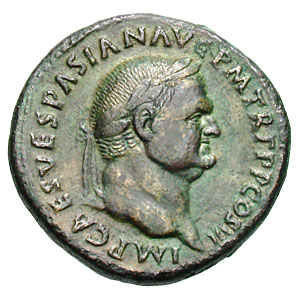 |
Five Grotesque Heads, circa 1490
pen and ink on paper, by Leonardo Da Vinci Location: Windsor Castle, Windsor, UK |
 |
Vespasian (69-79 AD)
Judaea Capta Sestertius
'Captive Jew & Mourning Jewess'
Rome, 71 AD
|
 |
Vespasian (69-79 AD)
Judaea Capta Sestertius
'Emperor & Mourning Jewess'
Rome, 71 AD
|
He's a familiar face, but in reality he's no friend of mine. History has a tendency to look on his reign with a measure of fondness since he was less bad than his predecessors (and his son Domitian much worse than him). That doesn't make him good. He was a real dirt bag (I just love his coins). He spent his life as a career General of the II Roman Legion, "Augusta" which saw heavy action in Britannia in 43-47 AD. His military career also took him to Germany, North Africa, Greece, Egypt and finally Judaea. His soldiers were devoted to him, and this eventually helped make him emperor. He is one of the few people to fall asleep during one of Nero's marathon lyre recitals and live to tell about it. He was spared because his services were badly needed by Nero. He was called on to pacify Judaea during the Jewish rebellion of 66-70 AD. He did so with the assistance of his look-alike son Titus (see below for coin), who assumed his command after Vespasian became emperor in 69 AD. The Judaea Capta ("Judaea Conquered") series of coins commemorate this bloody victory: one of the most brutal in Rome's history. It not only resulted in the destruction of the rebellion, but the complete destruction of Jerusalem and the temple and the death or enslavement of millions. This may be part of the reason Leonardo sketched him. He was a very bad man.
 |
| Titus (79-81 AD) Judaea Capta Sestertius 'Mourning Jewess with Weapons" Rome, 80-81 AD |
The Ugly Duchess, the subject of an earlier Grotesque study by Da Vinci was inspired by the original by Quentin Matsys. One has to wonder if the horrific reputation of Margaret Countess of Tyrol made her a candidate for Da Vinci's Grotesque study, just as the horrific reputation of Vespasian merited him the dubious honor of being one of the five heads in this picture. There would have been plenty of material on which Da Vinci could have based this study. Vespasian's image would have been easy to spot in Florence and Milan where he lived and worked. His coins are amongst the most plentiful of ancient Roman coins. The Judaea Capta series in particular was one of the most notorious in the way it celebrates Vespasian's atrocities. To me there is a striking resemblance between the coin and the sketch.
It's difficult for me to look at the faces in Da Vinci's Five Grotesque Heads sketch and conclude that these are anything other than very bad men. The overall sketch evokes the atmosphere of Imperial Rome. The fellow that is front left is the embodiment of sycophancy; the guy behind him is letting loose the proverbial evil laugh. The central figure with the oakleaf laurel has cold calculating eyes and resolute determination. I don't recognize him as an emperor of Rome--maybe he's a senator. I think my mother would describe the guy on the far right as a stunned banana. To me he looks like the master-mind behind the plot that has just unfolded. In the background is Vespasian, comfortable in very bad company.
Some think Da Vinci's Grotesque sketches are an artistic expression of the struggles between good and evil. Consider one of his most famous Grotesques, purported to the images of the Gypsy chieftan named Scaramuccia. The angle of his face resembles that of Judas Iscariot in the Last Supper (1497). In contrast other works are strikingly beautiful and heavily imbued with themes of righteousness. This is certainly true of many of his paintings, but also evident in sketches that are more comparable to the Grotesques. A fine comparator is the Burlington House cartoon at the National Gallery in London.
 |
| A Grotesque Head, 1504-1507 chalk on paper by Leonardo Da Vinci |
 |
| Portrait of a man in red chalk (self-portrait age 60), circa 1510 red chalk on paper by Leonardo Da Vinci Location: Royal Library, Turin, Italy |
There is no doubt a tendency for us to see those things we are looking for. Let me know if you see a resemblance between the coins and the sketch or if it's just my overactive imagination.


Interesting thoughts in these last two posts.
ReplyDeleteFor the record - I think da Vinci looks like a beautiful man. I see no ugliness. Perhaps no youthful perfection of form but he looks peaceful, kind, and intelligent. Approachable.
You've always been good at seeing the beautiful. It is impossible for me to look an Da Vinci's work and not love him. To me his self-portrait is beautiful--but still shows his imperfections. I love that honesty in him.
ReplyDelete